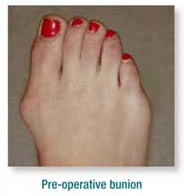Keyhole Bunion Surgery
The keyhole bunion surgery technique was developed by a society of French Surgeons in Bordeaux. Mr Palmer was one of the few English Surgeons to be trained and learn these techniques in 2007. Since then he and other UK surgeons have continued to develop their skills perform research studies in these minimally invasive techniques for all aspects of foot and ankle surgery.
The bunion surgery procedure is performed as a day case procedure and full weight bearing is allowed immediately. Bony healing time takes 6 weeks (although swelling may last a little longer.) It is important to be aware that most bunion operations are bone realignment procedures providing a straighter big toe, a narrower foot and a foot without a bunion. Rarely does simple removal of the bunion suffice.
The “keyhole” technique has a number of benefits over traditional ‘open’ surgery, such as: -
- Less invasive
- Less Scarring
- Less soft tissue trauma.
A stable and controllable realignment is achieved. Stabilisation of the fixation is either achieved with a temporary titanium wire and/or small specially designed bone screws inserted through very small incisions. The titanium wire remains in place for 4 weeks, and then is removed once healing is well underway. Bony healing seems to be relatively faster as the blood supply to the bone is preserved as a result of these minimally invasive techniques
Patients will be left with 2-3 small scars, from the minimally invasive incisions. Typically these will heal to less than 1cm each in size.
Please click here for a download of our recent scientific publication in International Orthopaedics Journal of this technique. Feel free to read our paper on comparison of minimally invasive bunion surgery with traditional open surgery which is also in press click here
See the latest NICE guidance for more information (which is now out of date).
See a copy of our full consent and information document on this technique by clicking here
Correction of the bunion with minimally invasive surgery








